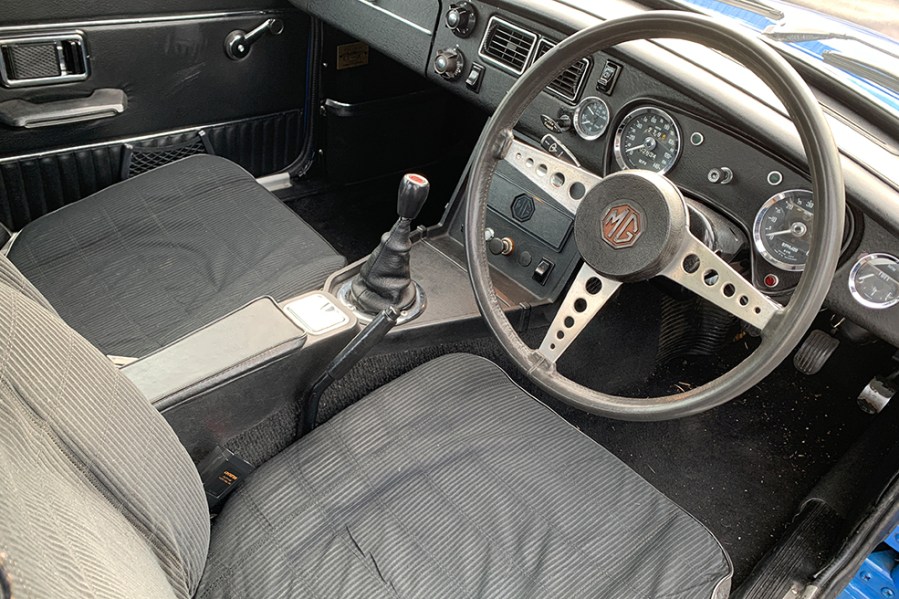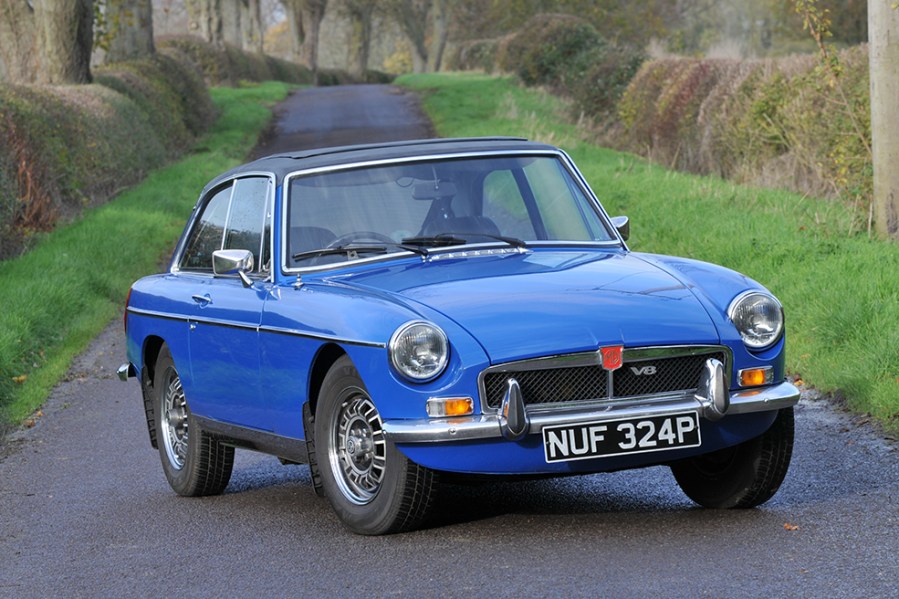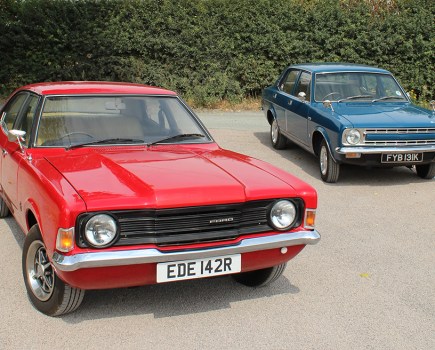The MGB GT V8 was a valiant attempt to give BL’s ageing sports car the shove many buyers had demanded. We get behind the wheel 50 years later
Words: Jeff Ruggles Images: Paul Wager
The MGB deservedly received plenty of fanfare in 2022 as enthusiasts commemorated 60 years of what is almost certainly Britain’s best-loved sports car, but for those who like their B with an extra batch of cylinders, it’s not time for those celebrations to end. The MGB V8 celebrated its golden anniversary in 2023 – it’s a car that battled the odds from the very start, and yet is now fondly remembered as one of the best BL products of the 1970s.
The V8 wasn’t Abingdon’s first attempt at a more powerful MGB. Five years after the roadster made its debut in 1962 and two years after the launch of the handsomely styled B GT coupe in 1965, the short-lived MGC was revealed using the six-cylinder BMC C-Series also found in the Austin 3 Litre. Sadly, the engine didn’t like to rev and was very heavy, which made the C understeer and saw just over 9000 sold in a production run lasting only two years. Nowadays the technology exists to greatly improve a C and they have become increasingly desirable, but back in period, MG was understandably reeling after getting its fingers burned.
In retrospect, the answer looked obvious. The creation of British Leyland Motor Corporation Ltd in 1968 saw MG and Rover become part of the same company, and Rover just happened to have a 3.5-litre Buick-derived V8 engine in its arsenal. However, MG wasn’t exactly showered with love under the new regime, led by ex-Triumph man Donald Stokes. Denied the ‘Specialist Car Division’ status of Jaguar, Triumph and Rover, the Abingdon firm was neglected to the extent that no replacement for the MGB was planned, and development of the existing car was limited to keeping it appealing in the marketplace.
Consideration was given to slotting the Rover V8 within the MGB’s wings, but it was deemed unfeasible without hefty structural changes. However, Kent-based racer and engineer Ken Costello had other ideas. Having spotted an example of the 3.5-litre alloy Buick V8 in a friend’s workshop, he had his first prototype MGB V8 up and running with a Rover P6 engine as early as late 1969. In the end, Costello would build around 225 examples, with the first production-spec car appearing in mid-1971.
Glowing press reviews prompted BL’s then Director of Engineering Charles Griffin to ask Costello for a closer look. Griffin was impressed with what had been achieved, and with Stokes equally impressed after another viewing, BL’s interest in a V8 MGB was rekindled. Essentially, it copied much of the Costello design for its own factory version, as well as shutting off his engine supply line and not paying him a penny. This effectively ended the Costello V8s, though a further 10 fuel-injected cars were produced at the tail end of the 1980s.

BL’s version was launched on August 15, 1973, using the GT bodyshell only. It used a low-compression version of the Rover V8 producing 137bhp rather than the P6’s 143bhp unit, which was then allied to a beefed-up four-speed gearbox with Laycock overdrive. Despite the reduction in power, the V8 was well suited to the B – the basic engine was lighter than the iron B-Series, and even with all its ancillaries, it weighed almost the same. And because it could manage 0-60mph in 8.5 seconds and a 125mph top speed, it was quick enough to see off the all-conquering Datsun 240Z.
Otherwise, the running gear was largely untouched. That meant lever-arm dampers front and rear, plus the B’s live axle and cart springs, though the latter were beefed-up springs to prevent axle tramp. To keep a lid on fuel consumption, the V8 was given the MGC’s tall 3.07:1 differential ratio, while the brakes were uprated with bigger front callipers and rear drums. These were concealed by new wheels specially developed by Dunlop, shod with wider rubber. Externally, the only other clues to the GT’s identity were a black honeycomb grille and discreet V8 badges positioned on the grille, nearside wing and tailgate.
The press were impressed by the car’s performance and even its fuel economy, but felt that it had been launched six years too late. Furthermore, the car was launched just as the effects of the 1973 Oil Crisis began to bite – no V8-powered car was going to be ideal when the national speed limit had been dropped to 50mph and petrol queues were rife.
For 1975, British Leyland rolled out the ‘federalised’ version of the MGB, resplendent with black Bayer Bayflex polyurethane bumpers and raised ride height to comply with the new US impact laws. A year later, the V8 model was quietly dropped. Demand had tailed off and supplies of V8 engines were tight in the run up to the launch of the Rover SD1. BL also shot itself in the foot by not offering the big-engined B in the lucrative US market, although the V8 would’ve needed work to meet American emission regulations – ironic given its Buick origins.
Just under a third of V8 models were ‘rubber’ bumper cars, and the car we’re driving today was one of them. I say ‘was’, because this Tahiti Blue example being offered for sale by Oxfordshire MG specialist Former Glory has been converted to wear the earlier chrome bumpers. And though the stigma attached to the rubber-equipped cars is much reduced these days, there’s no denying the purer look of chrome.

Some criticised the V8 in period for being too subtle looking and too similar to its four-pot stablemate, but any discretion evaporates when you turn the key as it bursts into life with a lovely deep burble. The standard B is a remarkably easy car to drive, but if anything, the huge amount of torque on offer makes the V8 even easier. You can pull away in second and slot it into top before you’ve got anywhere near urban speed limits, and that’s with much taller gearing than a regular 1.8-litre MGB.
Progress is still rapid when you push it too, accompanied by a glorious engine note. There’s no need to go mad with the revs though; it’s best to ride the torque and really enjoy the shove the V8 has to offer. The car’s flexibility is quickly evident, and it’s clear that it makes for an ideal grand tourer. Cog-swapping is easy too, though it did take some brain training to avoid slipping the gearbox into reverse by accident.
We didn’t push this very tidy example too hard into bends, but were impressed by its agility for such a big-engined car. Indeed, a lack of extra weight up front means that the basic B’s balance is retained, although it does feel a little less nimble thanks to wider tyres and heavier steering – the V8’s repositioned rack made the steering more direct at the expense of a little more effort.
Back in period, the seats were praised for being comfortable and well-suited to long journeys, though the dated dash design was lambasted for its ageing design, with What Car? suggesting it ‘went back to the ark’. Other criticisms at the time included that beefier rear suspension being too hard, making the tail end a bit skittish at speed and making the ride very coarse while driving around town. Wind noise at speed was reckoned to be another area exposed by the added performance, deemed at odds with the V8’s unflustered smoothness.
Had the V8 been launched back in 1967, instead of the MGC, then MG could have had themselves another world-beater. As it was, that superb engine and the excellent performance couldn’t counterbalance the limitations of an old design and poor planning, culminating in a car that was frustratingly out of step with the time period. In the end, just 2591 V8s were sold.
However, the characteristics that made the B GT V8 a flawed new car in 1973 accentuate its classic appeal today. Now, that familiar dash layout with its Smiths gauges feels appropriate for a traditional British sports car, and the suspension, while noticeably harder than a stock B, doesn’t feel too harsh to someone well versed in driving more modern cars with very low-profile tyres. What’s more, the wind noise is characteristic of a timeless shape, and for the mix of country lanes and built-up areas we experienced on our chosen route, wasn’t intrusive enough to overcome the V8 engine’s absolutely superb soundtrack.

MGB GT V8: our verdict
So while there’s a sense of frustration that the B GT V8 wasn’t as successful as the model could have been, there’s a feeling of awe, too. It’s a classic that’s relaxing to drive and easy to own, but also boasts a raw feel and sense of theatre that makes the experience behind the wheel feel like an event. It’s easy to see why so many rate it as the best MGB variant of all, belying its modest sales.
In any case, there was unfinished business. The idea of a V8 in an MGB would go on to have an enduring appeal – so much so that when Rover wanted to give the MG brand a boost in the early 90s ahead of the launch of the F, the hot MGB formula was revisited for a third time with the RV8, as Heritage roadster bodyshells were endowed with the 3.9-litre version of the revered V8 motor.





















